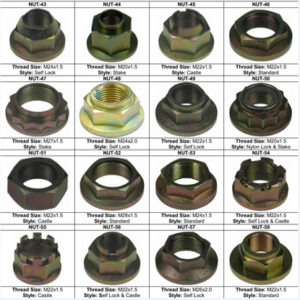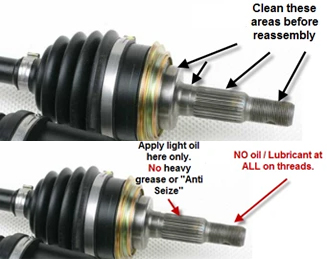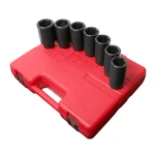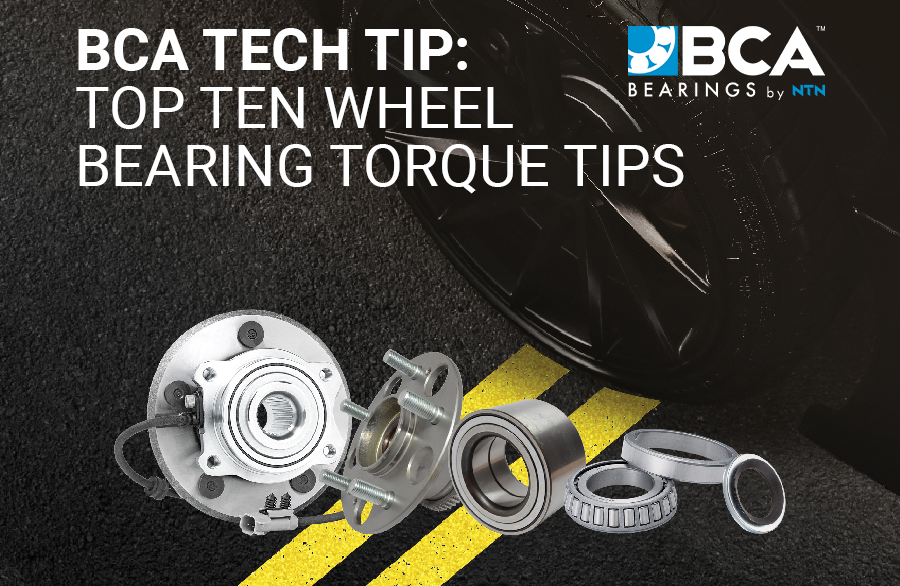A torque wrench is an essential tool when it comes to installing wheel bearings. Here are the top 10 tips to remember about these tools and procedures.
- CHECK THE RECOMMENDED TORQUE PROCEDURES AND SPECIFICATIONS
 It is nearly impossible to give a general torque specification or range for a wheel bearing axle nut. There can be significant differences, depending on bearing type and housing. Always check the service information for the correct procedure.
It is nearly impossible to give a general torque specification or range for a wheel bearing axle nut. There can be significant differences, depending on bearing type and housing. Always check the service information for the correct procedure.
Hub units can require many steps to set the final torque of the axle nut. On some hub units with factory-set preload, the axle nut might only secure the stub axle in the bore. On other hub units, the final adjustment is setting the load paths for the races and rolling elements. The torque specifications depend on the size of the bearings, the diameter of the axle and many other factors like the style of axle nut.
Wheel bearing manufacturers may use a different style nut that is included with the bearing. This nut may have a different torque specification – lower or higher – than the value listed in the service information. Some manufacturers will include this information in the box.
Even if you are installing a set of tapered roller bearings, it pays to look at the service information. Not all procedures and specifications are the same, and the method you learned from school or from your father might not work on some vehicles. - IF IT SAYS “ON THE GROUND,” DO IT ON THE GROUND
 Many vehicles require the wheels to be on the ground for the final torqueing of the axle nut to specifications. This ensures the proper mating of the split inner rings of the bearing needed to achieve the proper internal clearances. However, jamming a screwdriver in the fins of the rotor and bracing it against the caliper bracket might not achieve the same results. For specific instructions, refer to the vehicle manufacturer’s service information.
Many vehicles require the wheels to be on the ground for the final torqueing of the axle nut to specifications. This ensures the proper mating of the split inner rings of the bearing needed to achieve the proper internal clearances. However, jamming a screwdriver in the fins of the rotor and bracing it against the caliper bracket might not achieve the same results. For specific instructions, refer to the vehicle manufacturer’s service information. - USE A NEW NUT / Cotter Pin*
Some hub units and wheel bearing sets come with a new nut in the box. This is because the nut deforms to secure the hub unit to the axle. In these applications, a new nut must always be used when installing a hub. Reuse of the old nut could potentially cause the nut to loosen during vehicle operation. - CLEAN THE AXLE SHAFT BEFORE INSTALLATION
Clean and inspect the axle shaft before installing a new hub assembly. Use a fine file, wire brush, emery cloth or honing stone as appropriate to remove any debris, nicks or burrs from the splines. You can apply a light coating of oil to the splines. But don’t use any lubricants on the threads or washers. This can reduce friction on the threads and cause the nut to be over-torqued.
remove any debris, nicks or burrs from the splines. You can apply a light coating of oil to the splines. But don’t use any lubricants on the threads or washers. This can reduce friction on the threads and cause the nut to be over-torqued. - DON’T USE YOUR TORQUE WRENCH AS A SOCKET WRENCH
Use a torque wrench to apply a specific torque value during the final assembly process. Do not use a torque wrench as the primary means of tightening or loosening fasteners. Also, wind down the torque wrench before you put it back in your toolbox. - DON’T USE AN IMPACT
While it may appear to be easier to use an impact wrench, it is not recommended. OEM and bearing manufacturers always recommend using a torque wrench for installation. Using an impact to “run down” the axle nut can cause the assembly to be over-torqued. However, during removal, it is possible to use an impact. First, loosen the axle nut with a breaker bar if possible. Using this method can prevent causing damage to the stub axle or CV joint. - REPLACE A DAMAGED WHEEL HUB FLANGE BEFORE ASSEMBLY
When replacing a press-type wheel bearing and hub flange, it’s important that all the wheel-end parts properly work together after reassembly. A hub flange with damage to the shoulder the makes contact with the inner bearing can cause inconsistent torque values and lead to failure down the road. Wheel Hub flanges for most applications are available for many sources. - DO YOU TRUST YOUR TORQUE WRENCH?
For some hub units, the final torque specification can range from 150 to 350 ft/lbs depending on the application. Accurately tightening nut is critical to set the load paths for the bearings. But you must trust your torque wrench.
Torque wrenches designed for lug nuts typically have an upper limit of 190 to 200 ft/lbs. Even if the final torque for a hub unit is 185 ft/lbs, you could be at the limits of accuracy for your torque wrench. A torque wrench is most accurate in the middle, and almost every torque wrench is least accurate to the ends of its scale range of the wrench. So if the final torque is 200 ft/lbs, you would be better off using a torque wrench with 300 ft/lbs limit.
How do you determine if your torque wrench is accurate? Some tool trucks have a torque wrench tester that can help spot a torque wrench that is malfunctioning. You need to test at least several torque settings, including the highest and lowest settings. It is not uncommon to find a wrench that will be accurate at 50 ft./lbs., but significantly inaccurate at 25 or 150 ft./lbs. If the accuracy is off, you should send it out to be calibrated rather than buy another torque wrench. - USE AXLE NUT SOCKETS
 Axle nuts typically are recessed into the flange. The nut will normally be 29mm or larger and can be a six-point or 12-point hex. In some cases, the axle will protrude, preventing the use of a shallow socket. Tool manufacturers make sockets that are specific to axle nuts.
Axle nuts typically are recessed into the flange. The nut will normally be 29mm or larger and can be a six-point or 12-point hex. In some cases, the axle will protrude, preventing the use of a shallow socket. Tool manufacturers make sockets that are specific to axle nuts.
Using these sockets can prevent a comeback and damage to the nut. They can also increase torque wrench accuracy by fully engaging the nut. - DON’T FORGET THE OTHER TORQUE SPECIFICATIONS
Most hub units are held to the suspension knuckle using three or four fasteners. These fasteners have their own torque specifications and procedures. Some of these fasteners are torque-to-yield and can’t be used a second time because they have stretched. Also, some fasteners use thread-locking compounds that must be removed and reapplied.
Check Out Our Videos for More Info on this Topic:
- https://bcabearings.com/videos/axle-nut-torque-tips/
- https://bcabearings.com/videos/whats-the-deal-with-all-the-different-axle-nut-torque-specs/
- https://bcabearings.com/videos/torque-wrench-tech-tips-for-wheel-bearing-installation/
- https://bcabearings.com/videos/the-importance-of-proper-bearing-preload-during-installation/
